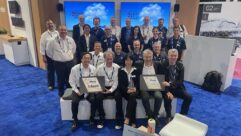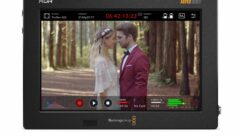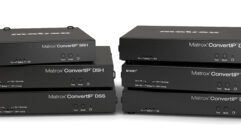CEDIA 2003 Wrap-Up—Video
Nov 12, 2003 12:00 PM,
By Peter Putman
PROJECTION HIGHLIGHTS
There were some excellent images being projected in booths and onthe trade show floor. In particular, the InFocus 3-chip prototype,Samsung’s new SP-H700A (designed with a lot of help from videoveteran Joe Kane), Digital Projection’s single- and 3-chipchassis, and Marantz’s VP-12S3 (single chip) will help to makepeople forget they ever heard of three-gun CRT projection. (I still useone, so what does that say about me?)
There is now so much DLP-engined product in the market that it hastaken a lot of the suspense out of press conferences. The minute SIM2announced a single-chip projector using the Matterhorn 1,024-by-576device; you knew at least half a dozen other manufacturers would haveit in short order. I am aware of at least six different 3-chip designsthat are being engineered for home theater, and the latest TIMustang/HD2+ 1,280-by-720 DMD is now popping up in nearly a dozenfront-projector designs.
Companies such as Panasonic, Sony, and JVC are countering withprojectors based on either high-temperature polysilicon or liquidcrystal on silicon (LCoS) devices. Most notable of these wasSony’s new Qualia projector, an enormous chassis that resembles ahigh-tech bathroom scale and employs three homegrown 1,920-by-1,080LCoS panels, dichroics, and a xenon lamp.
The Qualia dominated Sony’s booth, and lines to see its imageswere long all three days. I managed to sneak in to the demo an hourbefore the show closed on Sunday and watched about ten minutes of clipsfrom HDCAM, including some original 1,080i footage and film transfers.Image quality was quite good, except for what appeared to be somecompression at the high end of the gray scale (otherwise known ascrushed whites). I’ve seen this before with other LCoSdemos, both front and rear projected.
Although Sony’s Qualia did kick up a lot of interest, JVC hadan equally interesting and quieter demo off the floor at the Hyatt. Inaddition to a new product offering, the 1400 X 788 DLA-HX1U front D-ILA(also LCoS), I was able to see a prototype front LCoS projector with.8-inch 1,920-by-1,080 D-ILA panels that took up about one third asmuch room as the Sony box, and its picture quality wasn’t toobad. High black levels and some white crush were the usualsuspects.
Samsung’s entry into the front DLP market was one floor downin the Hyatt and showed a lot of homework had been done. Kane did thedemos himself on the SP-H700A, a distinct little box with selectablecolor gamuts (EBU/SMPTE/HDTV), numerous user-memory settings, and theability to directly input R,G,B color coordinates to get to a specificwhite point.
InFocus came into the market last year, and many of us editorsadopted a show-me posture when the folks from Oregon announced theyintended to be major players in the HT space. Well, after sellingseveral thousand projectors worldwide, it looks like they do have itall figured out and announced the ScreenPlay 7205 as their latestentry. This 1,280-by-720 DLP box employs Faroudja FLI2310 processorsand a seven-segment, five-speed color wheel.
Vidikron unveiled the Model 20 and Model 40 front DLP projectors,the difference being the Model 20 uses the Matterhorn 576p chip and theModel 40 goes all the way with a 1,280-by-720 native device. Meanwhile,corporate partner Runco (which never does anything low-key) announcedeight (that’s right, eight) new high-end 3-chip DLP machines thatprovide anything from 3,000 to 6,000 lumens with 1,280-by-1,024 DMDsand 720p, 960p, or 1,024p outboard processing.
Marantz demonstrated both an updated single-chip model, the VP-12S3,and a 3-chip prototype that was running a bit on the red side but stilllooked good. Digital Projection is poised to compete in the $10K-and-upprojector arena with a bunch of products. One is the supersmall iVisionHD, a single-chip 1,280-by-720 DLP design that weighs but 6.6 pounds.The 3-chip Mercury HD was in evidence, and there are even plans tobring out a 3-chipper using the new 2K cinema-grade DMDs.
Optoma had the H76, the price leader in the single-chip 1,280-by-720arena. This box is selling for less than $8K and has the potential tobe a disruptive product in terms of price, as does BenQ’s PE8700,which is a similar product and sells in the same price range. SIM2 hadthe Domino on display, and that little wonder makes use of theMatterhorn 576p DMD device to compete at a lower price with other 576pand 1,024-by-768 front projectors.
FLAT PANELS
Projection wasn’t the only highlight of the show. In fact, thedeluge of flat-panel technology into the CE and HT markets has thepotential to be another slam dunk. With all of the oversupply and pricewars taking place in Asia, the field of plasma and LCD resellers andretailers is more crowded than the recent California recallelection.
The writing is clearly on the wall: flat-panel TVs are the wave ofthe future, and that wave is coming faster than many analysts expected.The forecast is for flat-panel technologies to surpass CRT displays by2005 in all categories, and with plasma and LCD TVs and monitors nowavailable in sizes from 10 inches all the way to 63 inches (with some70-inch and 72-inch product in the works), the battleground will extendeven to rear-projection TVs using microdisplay technologies such as(what else?) DMDs and LCoS panels.
Here were some of the highlights:
Samsung is one of the big players in this market with both LCD andplasma fabrication lines running full tilt in Korea. The company isinto its third generation of plasma with four models, starting with the42-inch SPN4235 (852 by 480) and 42-inch HPN4239 (1,024 by 768 ns).Both have integrated NTSC tuners and a fanless design for cooling tokeep noise down. The 50-inch HPN5039 (1,366 by 768) and 63-inch HPN6339(1,366 by 768) will also include NTSC tuners. All four models offer DVIinputs and Digital Natural Image processing.
In the LCD arena, Samsung offers the LTN406W, a 40-inch wide-screenNTSC TV with 1,280-by-768 resolution and the even larger 46-inchLTN468W (1,280 by 768). There are 22-inch (LTN265W) and 32-inch(LTN325W) models also in the new line. All of ’em useSamsung’s Patterned Vertical Alignment LC crystal process forwider viewing angles.
LG showed up with new 42-inch, 50-inch, and 60-inch plasma monitors.The RU-42PZ90 has an integrated NTSC tuner, and the 50-inch MU-50PZ90Vand 60-inch MU-60PZ90V are monitors only. Similar products with theZenith brand were also on display (the P42W34, P50W38, and P60W38). Ofparticular interest was the DU-42PZ60, a 42-inch plasma HD-ready TVusing a 1,024-by-768 (nonsquare) pixel matrix. This product featured abuilt-in NTSC and ATSC tuner, a first in its category.
No discussion of flat-panel TVs would be complete without a mentionof Sharp, the worldwide leader in LCD TV sales. It unveiled the new30-inch LC-30HV6U and 37-inch LC-37HV6U integrated LCD TVs but with anew horizontal speaker design below the screen. Sharp had a neattechnology demo featuring the LC-15L1U-US, a 15-inch LCD TV equippedwith a 802.11b wireless card and batteries for a true portable LCD TVsystem.
The new and improved Vidikron added three plasma monitors into theirline. The VP-42 is a 42-inch 480p monitor that is HD-ready, as is the50-inch VP-50 (1,366 by 768) and the 60-inch VP-60 (1,366 by 768). RCAis also a player with two LCD TVs. The LCDS2022B is a 20-inch designwith 800-by-600 resolution and 160-degree viewing angle, and theLCDX2722W sports 1,280-by-768 resolution, DVI input, and 170-degreeviewing angles.
Fujitsu had a couple of surprises, including the first-ever 50-inchplasma monitor assembled at the Fujitsu-Hitachi plant. The P55HXAactually measures 55 inches diagonally and sports 1,366-by-768resolution, and it uses the familiar Alternate Lighting of Surfacestechnology found in 42-inch Fujitsu and Hitachi models. A 63-inch model(ostensibly OEM’ed from Samsung) also made a debut and is brandedas the P63XHA. (Hitachi also had its version of the 55-inch panel ondisplay as a technology prototype.)
Panasonic showcased the 42-inch TH-42PX20U and 50-inch TH-50PX20Uplasma monitors. Both offer an integrated NTSC tuner and two speakers,Photo Viewer SD and PCMCIA slots, and a pedestal stand. In the world ofsmaller screens, Panasonic’s 22-inch TC-22LH1 and 32-inchTC-32LH1 are LCD TVs with 1-280-by-768-pixel resolution and HDMIinputs. Sony is also onboard with a new 26-inch LCD TV. The KLV-26HG2WEGA is an HD-ready set with integrated NTSC tuner, a Memory Stick slotfor JPEG and MPEG1 playback, and updated speaker design.
There were several other companies showing a variety of small LCDTVs in the 10- to 17-inch-size range. Many of those have Wide XGA(1,280 by 768) resolution and are suitable for use in small rooms,kitchens, or even as carry-around TVs if power is available. Luce,Samsung, Sharp, and Zenith are all well represented in this productcategory. None of these products are ATSC-ready, although Luce did showa larger LCD TV with a built-in ATSC tuner earlier this year.
GOT FLAT IF YOU WANT IT
This recap is by no means exhaustive, but it does give you a prettygood idea of how the market is being redefined by microdisplay andflat-panel technologies. Eventually, the two will compete head-to-headin 40-inch and higher screen sizes. Right now DLP has the advantage inprice; RCA’s 61-inch DLP rear-projection TV lists for $4,500, anda comparable 61-inch plasma monitor is close to $20K, but that willsurely change with time.
The prediction is that LCD monitors and TVs will take over themarket up to 40 inches and 42 inches within a couple of years, withplasma still hanging on in larger sizes. LG and Samsung have both shownLCD TVs with screens larger than 50 inches, and Sharp has a 60-inchversion in the works. But these are not viable products yet and far toopricey to compete with plasma and even rear-projection TVs. But the dayis coming.










